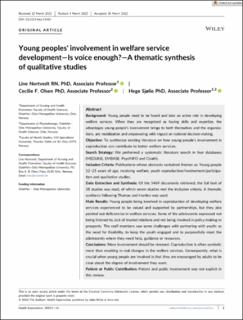| dc.contributor.author | Nortvedt, Line | |
| dc.contributor.author | Olsen, Cecilie Fromholt | |
| dc.contributor.author | Sjølie, Hege | |
| dc.date.accessioned | 2022-05-27T11:41:34Z | |
| dc.date.available | 2022-05-27T11:41:34Z | |
| dc.date.created | 2022-03-24T15:32:32Z | |
| dc.date.issued | 2022 | |
| dc.identifier.citation | Health Expectations. 2022, 1-14 | en_US |
| dc.identifier.issn | 1369-6513 | |
| dc.identifier.uri | https://hdl.handle.net/11250/2996453 | |
| dc.description | This is an open access article under the terms of the Creative Commons Attribution License, which permits use, distribution and reproduction in any medium, provided the original work is properly cited. | en_US |
| dc.description.abstract | Background: Young people need to be heard and take an active role in developing welfare services. When they are recognized as having skills and expertize, the advantages young people's involvement brings to both themselves and the organizations, are mobilization and empowering with impact on national decision‐making.
Objective: To synthesize existing literature on how young people's involvement in coproduction can contribute to better welfare services.
Search Strategy: We performed a systematic literature search in four databases (MEDLINE, EMBASE, PsycINFO and Cinahl).
Inclusion Criteria: Publications whose abstracts contained themes as: Young people 12–25 years of age, receiving welfare, youth coproduction/involvement/participation and qualitative studies.
Data Extraction and Synthesis: Of the 5469 documents retrieved, the full text of 58 studies was read, of which seven studies met the inclusion criteria. A thematic synthesis following Thomas and Harden was used.
Main Results: Young people being involved in coproduction of developing welfare services experienced to be valued and supported by partnerships, but they also pointed out deficiencies in welfare services. Some of the adolescents expressed not being listened to, lack of trusted relations and not being involved in policy making or prospects. The staff members saw some challenges with partnering with youth; as the need for flexibility, to keep the youth engaged and to purposefully meet the adolescents where they need help, guidance or resources.
Conclusions: More involvement should be stressed. Coproduction is often symbolic more than resulting in real changes in the welfare services. Consequently, what is crucial when young people are involved is that they are encouraged by adults to be clear about the degree of involvement they want.
Patient or Public Contribution: Patient and public involvement was not explicit in this review. | en_US |
| dc.language.iso | eng | en_US |
| dc.publisher | John Wiley & Sons | en_US |
| dc.rights | Navngivelse 4.0 Internasjonal | * |
| dc.rights.uri | http://creativecommons.org/licenses/by/4.0/deed.no | * |
| dc.subject | youth | en_US |
| dc.subject | systematic review | en_US |
| dc.subject | social welfare | en_US |
| dc.subject | social participation | en_US |
| dc.subject | qualitative research | en_US |
| dc.subject | patient participation | en_US |
| dc.subject | adolescent | en_US |
| dc.title | Young peoples' involvement in welfare service development—Is voice enough?—A thematic synthesis of qualitative studies | en_US |
| dc.type | Peer reviewed | en_US |
| dc.type | Journal article | en_US |
| dc.description.version | publishedVersion | en_US |
| dc.rights.holder | © 2022 The Authors. | en_US |
| dc.source.pagenumber | 1-14 | en_US |
| dc.source.journal | Health Expectations | en_US |
| dc.identifier.doi | 10.1111/hex.13485 | |
| dc.identifier.cristin | 2012369 | |
| cristin.ispublished | true | |
| cristin.fulltext | original | |
| cristin.qualitycode | 1 | |

